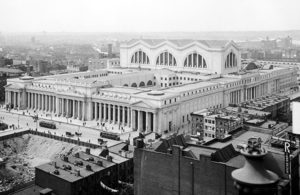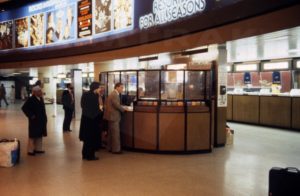A Look at the History Behind the Nation’s Busiest Rail Hub
With more than half a million Amtrak and commuter customers passing through its concourses every day, New York Penn Station is the busiest rail hub in North America. Located in the West Midtown area of Manhattan, New York Penn Station brings together Amtrak, Long Island Rail Road (LIRR) and New Jersey Transit (NJ Transit) services and is readily accessible from more than a dozen subway lines. New York Penn Station also consistently ranks as the busiest in Amtrak’s national network, accommodating more than 10 million customers last year.
The Original Pennsylvania Station
 The station takes its name from the Pennsylvania Railroad (PRR), which opened the original Pennsylvania Station in fall 1910. Prior to that time, most train trips to New York City from the west and the south ended at Jersey City, N.J. The broad Hudson River was a formidable obstacle for bridge and tunnel builders, and schemes advanced in the late 19th century would have required vast sums of money to complete even if feasible. Railroads settled upon ferry service across the river to reach the island of Manhattan.
The station takes its name from the Pennsylvania Railroad (PRR), which opened the original Pennsylvania Station in fall 1910. Prior to that time, most train trips to New York City from the west and the south ended at Jersey City, N.J. The broad Hudson River was a formidable obstacle for bridge and tunnel builders, and schemes advanced in the late 19th century would have required vast sums of money to complete even if feasible. Railroads settled upon ferry service across the river to reach the island of Manhattan.
But by the turn of the century, the PRR decided it had to find a way into the heart of the country’s largest metropolitan area, dominant port and business center. Pennsylvania Station became just one piece of a larger multi-million dollar puzzle that included a new right-of-way from Newark, N.J., to Manhattan; tunnels underneath the Hudson and East Rivers; bridges; and a new rail yard in Queens.
As completed in 1910, the station had two parts: the portion below street level where the platforms and tracks were located, and the above ground area that contained passenger spaces, including waiting rooms, a concourse, ticketing desks and storefronts. The above ground portion was demolished in the 1960s to build Madison Square Garden and an office tower. Destruction of this monumental neoclassical structure, designed by noted architectural firm McKim, Mead and White, is often considered one of the driving forces behind the modern historic preservation movement. The underground portion remains in use today, accommodating about 1,300 Amtrak, NJ Transit and LIRR trains every weekday.
Amtrak Takes Ownership
 Amtrak gained ownership of the station, by then called Penn Station, in 1976 when it acquired the majority of the 457-mile Northeast Corridor (NEC) linking Washington, D.C., and Boston via New York City. Then, as now, the NEC was considered the busiest railroad line in North America. In 1976, it averaged 960 trains a day: about 120 Amtrak trains, 660 commuter trains and 170 freight and mail trains. For comparison, last year the NEC accommodated about 2,200 daily trains, most of which were operated by eight commuter rail agencies.
Amtrak gained ownership of the station, by then called Penn Station, in 1976 when it acquired the majority of the 457-mile Northeast Corridor (NEC) linking Washington, D.C., and Boston via New York City. Then, as now, the NEC was considered the busiest railroad line in North America. In 1976, it averaged 960 trains a day: about 120 Amtrak trains, 660 commuter trains and 170 freight and mail trains. For comparison, last year the NEC accommodated about 2,200 daily trains, most of which were operated by eight commuter rail agencies.
Since 1976, the number of Amtrak and commuter trains serving New York Penn Station has doubled. One of the many rail service improvement projects that contributed to this increase in frequencies was the opening of Amtrak’s West Side Connection in 1991. By refurbishing a shuttered freight line along the Hudson River, Amtrak created a direct connection to Penn Station for trains serving destinations north of New York City – which, until that point, had used Grand Central Terminal. This let Amtrak consolidate all services at Penn Station, allowing for seamless connections and eliminating the need to maintain services at two stations.
Penn Station Improvement Initiatives
In 2017, Amtrak announced a series of initiatives to strengthen railroad infrastructure and improve operations and preparedness at New York Penn Station. While the reconstruction of the station’s aging tracks had been scheduled to take place over several years, President and CEO Wick Moorman determined that continuity of travel in the region depended on making the much needed repairs sooner. In addition to the intensive series of major track and switch projects, Amtrak announced it would embark on a series of initiatives to improve overall passenger experience, safety and security at the station.
Looking Towards the Future
 In the 1990s, U.S. Senator Daniel Patrick Moynihan proposed transforming the old post office building west of Penn Station – known as the James A. Farley Building – into a grand new entrance to the station. After the senator died in 2003, the concept took the name “Moynihan Station.”
In the 1990s, U.S. Senator Daniel Patrick Moynihan proposed transforming the old post office building west of Penn Station – known as the James A. Farley Building – into a grand new entrance to the station. After the senator died in 2003, the concept took the name “Moynihan Station.”
Amtrak, in partnership with the New York Empire State Development Corporation and its subsidiary Moynihan Station Development Corporation, is now creating the future home of its New York City passenger operations within a new train hall in Moynihan Station. It will offer enhanced passenger facilities for NEC and long-distance travelers. In companion with the existing Penn Station – which will be renovated to better serve commuters and intercity passenger arrivals – expansion of passenger services into Moynihan Station will relieve existing station crowding and improve passenger comfort and security.
The Moynihan Station project is being constructed in two phases. Phase I, which is near completion, includes expansion and enhancement of a 33rd Street Connector between Penn Station and the Moynihan Lower Concourse; the extension and widening of the concourse to serve nine of Penn Station’s 11 platforms; new access points and passenger circulation space; and entrances into the new concourse at the 31st and 33rd Street corners of the Farley Building.
Phase II, now in early-stage construction, will create the Moynihan Train Hall, a world-class boarding concourse for Amtrak and LIRR customers. In addition to a sunlit atrium, it will include a combined ticketing and baggage area, an Amtrak Metropolitan Lounge, a reserved customer waiting room, casual waiting space and retail and food shops. The Moynihan Train Hall is expected to be complete by late 2020 in time for the arrival of Amtrak’s next-generation high-speed Acela Express trainsets.




